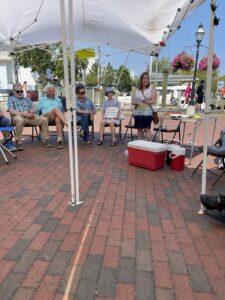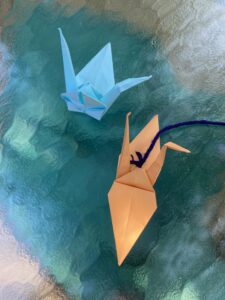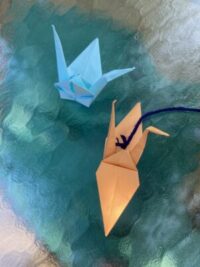Dear Friends,
Annapolis Friends and others gathered for a vigil at City Dock on August 6th, 2023 to mark the 78th Anniversary of the Bombing of Hiroshima and Nagasaki. We met to honor the 150,000+ lives lost, to revisit the horrors of war, and to share our concern that the world is in a perilous moment, at extreme risk of nuclear strikes, intended or unintended, that would lead to nuclear war, catastrophic loss of life and further imperil our already climate-threatened planet.
The vigil was sponsored by Annapolis Friends Meeting and Anne Arundel Peace Action. Phil C., clerk of the AFM Peace and Social Concerns Committee welcomed those who gathered. After Friend Phil spoke of the 1945 atomic bomb attack, the proliferation of nuclear weapons, and the recent Russian threats to use nuclear weapons, he concluded with a query to those gathered. He invited all to reflect on “What can we, as Friends and/or as individuals, do to avert a nuclear holocaust?”
Friends observed silence…


Friends and others responded to the query.
Among those who spoke, two Annapolis Friends shared personal testimonies. We invite readers to read Wes J.’s testimony as reported in today’s cover story by Luke Parker entitled, “Crofton Navy veteran pushes for nuclear disarmament 78 years after Hiroshima, Nagasaki bombings“.
AFM Friend, JoAnna S. shared the following comments at the Vigil, which include a discussion of the US incarceration of Japanese citizens, and the symbolic wish and gift left behind by a young short-lived survivor of the atomic bombing, an example of which each of us was given and which we held aloft in remembrance.
“Peace Crane Notes –
Intro: Everyone who wants, please take a paper crane.
The horror of nuclear war is on our doorsteps again – this time with threats from Russia against people who are their near kin in Ukraine. We need diplomatic action, but we also need the small steps and symbols that lead to peace.
Violence and peace are often bred in the experience of children. We have been focusing today on what happened in Hiroshima and Nagasaki, but let’s remember also what happened to Japanese living in the U.S. at the time. We put them in camps and took away their businesses, freedom and livelihood. Not so different from Hitler, except we did not kill them.
In the 1990s I was running an intergroup relations project in Philadelphia called Bridges, and Bill Kishi, a Japanese-American man who was about 10 when the war started and from Seattle like me, was our cooking mentor. During one of our large group events he talked about how bitter he was due to treatment during the war, and how he convinced his family to move east after the war because it was too painful to return to his home. He had a hard life, and even as a Friend for many years, was still angry.
I asked my mother, who was about the same age, about what she remembered about the Japanese Americans during the war. She told me how her parents, who were deeply involved in interfaith action for peace and justice, were part of an interfaith coalition that kept Japanese farms and businesses in trust. She cried as she told me about how after the war they met a returning Japanese farmer who raised roses with an armful of his flowers, indicating that his land and farm were being returned in the condition he left it in. Unlike Bill, this farmer knew and felt peace. And like this farmer, our small, symbolic actions and those of many others, can make a real difference in ensuring that Hiroshima never happens again.
Perhaps one of the best-known examples of gestures that have deep meaning for peace is Sadako Sasaki’s peace cranes.
Sadako was 2 when the bomb fell on Hiroshima, experiencing radiation but not the fires and immediate physical effects. She was healthy until she was about 12, when she became severely ill with Leukemia, also known as the bomb disease.
During the last 8 months of her life, while living in the hospital, Sadako learned that Japanese folklore says that a crane can live for a thousand years, and a person who folds an origami crane for each year of a crane’s life will have their wish granted.
When her wish did not come true after she made her thousand cranes, she switched her wish to clearing her father’s debt, and continued making them until she died in a room full of 1,300 cranes in October 1955, age 12.
Sadako’s peace cranes did not go unnoticed and by the time she died, her story and message of the impact of war on children and wishes for peace had become international news and an important symbol for efforts to stop the use of nuclear weapons forever. There is a memorial that looks like her with a message from her brother at the Children’s memorial park for the bomb victims in Hiroshima.
Each of us can carry her message into the world.
Please raise your cranes as I read Sadako’s explanation to the United States Committee for Cooperation with the Japan Council Against A and H Bombs (published in Report from Hiroshima (1961), p 48) about why she made her cranes:
[Everyone: to say aloud]
I will write peace on your wings and you will fly all over the world.
Thank you.”
JAS

Photos of Peace Vigil attendees – courtesy of Cecile T.
